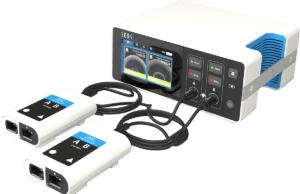
The study results with the Ekos system (BTG) were presented at the International Society on Endovascular Therapy (ISET; 3–7 February 2018, Florida, USA).
The findings confirm that bilateral pulmonary embolism patients treated in as little as two hours with a total tissue plasminogen activator (tPA) dose as low as 8mg continue to show improvements in right ventricular-to-left ventricular diameter ratio (RV/LV) ratio over the long term with a very low all-cause mortality rate of 2%, an equally low recurrent pulmonary embolism rate of 2%, and continued quality of life improvements. These data further demonstrate the efficacy and safety of the OPTALYSE PE treatment regimens, a press release from BTG states.
“The long term follow-up results reinforce that a new interventional standard is being set for pulmonary embolism treatment,” said principal investigator Victor Tapson, director, VTE and Pulmonary Vascular Disease Research Program, Cedars-Sinai Medical Center, Los Angeles, USA. “The 2% one-year all-cause mortality rate observed in OPTALYSE PE is much lower than the ~8% rate seen in comparable anticoagulation studies. This is important for institutions that are adopting the new low-dose, shorter duration treatments explored in OPTALYSE PE.”
The authors followed the 12-month outcomes of 101 patients at 17 centres who participated in the OPTALYSE PE study in which the patients were randomised to one of four cohorts. These patients were diagnosed with acute proximal pulmonary embolism in at least one main or proximal lobar pulmonary artery and an RV/LV greater or equal to 0.9 on chest CTA. Patients received treatment within 48 hours of diagnosis. The four cohorts ranged from 2–6 hours in treatment duration and 8mg to 24mg total tPA for bilateral pulmonary embolism.
All cohorts saw a significant reduction in RV/LV by approximately 23 to 26% taken via CTA at 48 hours. For follow-up, patients received echocardiograms at four hours, 48 hours, 30 days, 90 days, and at one year post-Ekos therapy. The initial significant reductions in RV/LV continued to improve in all cohorts through one year – with mean RV/LV ratios in the 0.70 range at one year for all cohorts. Multiple quality of life measurements showed valuable improvements between 30 days and 365 days—further demonstrating the long-term benefit of Ekos therapy.
“Ekos is the only device cleared for the treatment of pulmonary embolism. This is the first time that long-term mortality and quality of life data has been reported for an interventional pulmonary embolism treatment, which continues to show our commitment to evidence-based innovation, predictable and cost-effective procedures, and strong safety profiles that improve patient outcomes and help make the most challenging cases easier,” said Ekos vice president and general manager Matt Stupfel.
A separate registry study, KNOCOUT PE, is currently underway to measure how hospitals are adopting and benefiting from the new standard of care. At full enrolment, the KNOCOUT PE study is expected to include as many as 100 centres internationally. Cases will include those from before and after the release of the original OPTALYSE PE study.









